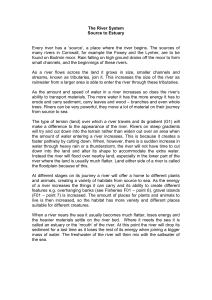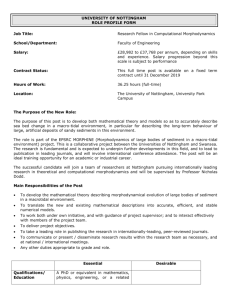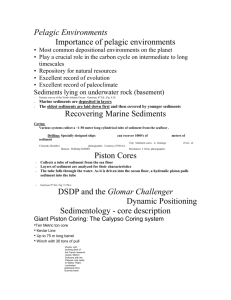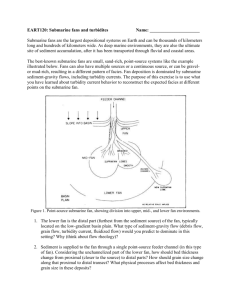1D SEDIMENT TRANSPORT MORPHODYNAMICS with
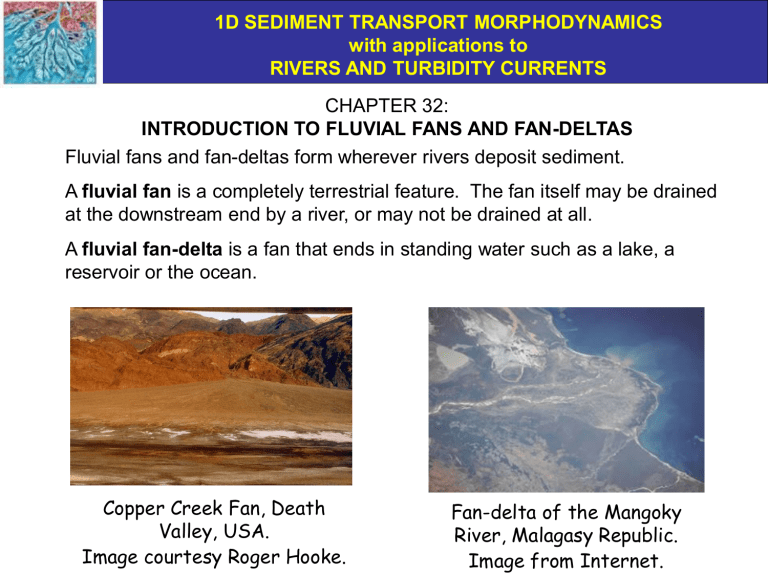
1D SEDIMENT TRANSPORT MORPHODYNAMICS with applications to
RIVERS AND TURBIDITY CURRENTS
CHAPTER 32:
INTRODUCTION TO FLUVIAL FANS AND FAN-DELTAS
Fluvial fans and fan-deltas form wherever rivers deposit sediment.
A fluvial fan is a completely terrestrial feature. The fan itself may be drained at the downstream end by a river, or may not be drained at all.
A fluvial fan-delta is a fan that ends in standing water such as a lake, a reservoir or the ocean.
Copper Creek Fan, Death
Valley, USA.
Image courtesy Roger Hooke.
Fan-delta of the Mangoky
River, Malagasy Republic.
Image from Internet.
1D SEDIMENT TRANSPORT MORPHODYNAMICS with applications to
RIVERS AND TURBIDITY CURRENTS
CHARACTERISTICS OF FLUVIAL FANS AND FAN-DELTAS
Fluvial fans and fan-deltas are depositional zones that are larger than the rivers that create them.
Fluvial fans and fan-deltas spread out laterally. The river(s) on them access the fan surface by migration and avulsion (channel jumping), so creating the characteristic fan-shaped surface.
The long profile of a river on a fan is driven to be upward-concave by sediment deposition.
Fluvial fans and fan-deltas tend to prograde outward in space as sediment deposits.
Fans and fan-deltas tend to form in zones of tectonic subsidence.
Subsidence creates a “hole” that is filled with sediment.
Fan-deltas are strongly influenced by variations in the level of standing water
(base level).
1D SEDIMENT TRANSPORT MORPHODYNAMICS with applications to
RIVERS AND TURBIDITY CURRENTS
A LARGE FLUVIAL FAN
The Kosi River flows southward from the
Himalaya Mountains and deposits a large fan drained by the Ganges River.
The fan is located within a subsiding foreland basin between the uplifting
Himalaya Mountains to the north and the highlands of India to the south.
Most of the sediment carried by the Kosi
River deposits on the fan and never reaches the Ganges River.
Kosi River and Fan, India (and adjacent countries).
Image from NASA; https://zulu.ssc.nasa.gov/mrsid/mrsid.pl
1D SEDIMENT TRANSPORT MORPHODYNAMICS with applications to
RIVERS AND TURBIDITY CURRENTS
CHANNEL SHIFT ON A LARGE FLUVIAL FAN
Channel shift on the Kosi River was introduced in Chapter 25. The map makes clear the fan-shaped deposit created by channel shift.
Channel shift on the Kosi Fan.
Adapted from Gole and Chitale (1966).
1D SEDIMENT TRANSPORT MORPHODYNAMICS with applications to
RIVERS AND TURBIDITY CURRENTS
CHANNEL SHIFT ON AND PROGRADATION OF A FAN-DELTA
The Yellow River Delta, China, is a muddy delta that subsides due to compaction driven by the weight of its deposits. This subsidence acts to limit delta progradation.
Yellow River Delta, China.
Image from NASA; https://zulu.ssc.nasa.gov/mrsid/mrsid.pl
Channel shifting in the Yellow River Delta
From Sun et al. (2002) based on
Pang & Si (1983).
The river
1D SEDIMENT TRANSPORT MORPHODYNAMICS with applications to
RIVERS AND TURBIDITY CURRENTS
THE FAN AND ITS RIVER(S)
At any given time a fan may contain a single river, or multiple distributaries. These rivers may be meandering or braided.
The Kosi River is braided in its upper reaches.
The fan
The same river is meandering in its lower reaches.
1D SEDIMENT TRANSPORT MORPHODYNAMICS with applications to
RIVERS AND TURBIDITY CURRENTS
A FAN CREATED BY MEANDERING RIVER(S)
The Okavango River forms a large fan where it flows into a graben (zone of subsidence associated with extension of the continental crust) in Botswana, Africa.
Meandering channel on the
Okavango Fan.
Image courtesy
N. Smith.
Satellite view of Okavango
Fan.
Okavango Fan, Botswana, Africa.
Image from Smith et al. (1997).
Image from NASA; https://zulu.ssc.nasa.gov/mrsid/mrsid.pl
1D SEDIMENT TRANSPORT MORPHODYNAMICS with applications to
RIVERS AND TURBIDITY CURRENTS
FAN-DELTAS CREATED BY BRAIDED RIVERS
A sandur is a large fan or fan-delta created by a braided stream carrying sediment from a glacier. The word is Icelandic in origin. The braided Kurobe River is confined by dikes to protect the cultivated land on the fan.
Skeithara Sandur, Iceland.
Image courtesy H. Johannesson.
Kurobe Fan-delta, Japan.
Image courtesy S. Ikeda.
1D SEDIMENT TRANSPORT MORPHODYNAMICS with applications to
RIVERS AND TURBIDITY CURRENTS
FANS AND FAN-DELTAS AT VARIOUS SCALES
Laboratory fan-delta, ~ 3 m.
Image taken at St. Anthony Falls Laboratory, University of Minnesota USA.
1D SEDIMENT TRANSPORT MORPHODYNAMICS with applications to
RIVERS AND TURBIDITY CURRENTS
FANS AND FAN-DELTAS AT VARIOUS SCALES contd.
Fan created by runoff from cultivated field; ~ 6 m.
Image taken by author near Pigeon Point, California.
1D SEDIMENT TRANSPORT MORPHODYNAMICS with applications to
RIVERS AND TURBIDITY CURRENTS
FANS AND FAN-DELTAS AT VARIOUS SCALES contd.
Fan in Idaho, USA created by runoff from burned hillside, ~ 50 m.
1D SEDIMENT TRANSPORT MORPHODYNAMICS with applications to
RIVERS AND TURBIDITY CURRENTS
FANS AND FAN-DELTAS AT VARIOUS SCALES contd.
Copper Creek Fan, Death Valley, USA; ~ 10 km.
Image courtesy Roger Hooke.
1D SEDIMENT TRANSPORT MORPHODYNAMICS with applications to
RIVERS AND TURBIDITY CURRENTS
FANS AND FAN-DELTAS AT VARIOUS SCALES contd.
Kosi River Fan, India; ~ 125 km.
Image from Internet.
1D SEDIMENT TRANSPORT MORPHODYNAMICS with applications to
RIVERS AND TURBIDITY CURRENTS
BAJADAS
A bajada is a set of closely-spaced fans that have amalgamated to form a single linear morphology. Two examples are shown below.
Bajada in western China
Images from NASA; https://zulu.ssc.nasa.gov/mrsid/mrsid.pl
Bajada in Death Valley,
California, USA
1D SEDIMENT TRANSPORT MORPHODYNAMICS with applications to
RIVERS AND TURBIDITY CURRENTS
FLOWS THAT CREATE FANS
Fans may be created by deposition from a) debris flows, b) sheet flows and c) river flows.
a) A debris flow is a dense flow that contains similar amounts by weight of water and sediment.
b) A sheet flow is a broad, unchannelized open channel flow that may cover a significant fraction of the fan (e.g. 30%) during a single flood.
c) A channelized flow is within a meandering or braided channel.
Debris flow and sheet flow fans tend to occur on slopes that are much steeper than fluvial fans created by channelized flows. The two do, however, have a range of overlap.
Here the case of fluvial fans created by channelized flows are considered in detail. It is of use, however, to view some debris flow fans before proceeding.
1D SEDIMENT TRANSPORT MORPHODYNAMICS with applications to
RIVERS AND TURBIDITY CURRENTS
A DEBRIS FLOW (JAPAN)
Double-click on the image to see the video. Video courtesy Paul Heller.
rte-bookjapandebflow.mpg: to run without relinking, download to same folder as PowerPoint presentations.
1D SEDIMENT TRANSPORT MORPHODYNAMICS with applications to
RIVERS AND TURBIDITY CURRENTS
HARVEY CREEK FAN, PAPUA NEW GUINEA
Harvey Creek Fan, Papua New Guinea is a fan dominated by debris flows created by the disposal of mine waste. It grades smoothly into a braided stream (Ok Mani) downstream.
Mine disposal site
Zone of valley wall erosion
Harvey Creek
Fan Braided Ok
Mani
Image courtesy Ok Tedi Mining Ltd.
1D SEDIMENT TRANSPORT MORPHODYNAMICS with applications to
RIVERS AND TURBIDITY CURRENTS
HARVEY CREEK FAN, PAPUA NEW GUINEA contd.
While the fan is mostly formed by debris flows, fluvial flow also plays a role. Bill Dietrich of the
University of California Berkeley serves as scale.
1D SEDIMENT TRANSPORT MORPHODYNAMICS with applications to
RIVERS AND TURBIDITY CURRENTS
A FAN-DELTA CREATED BY A DEBRIS
FLOW EVENT
A combination of debris flows and sheet flows associated with the Vargas Disaster, Venezuela,
1999 destroyed the town of
Carmen de
Uria.
March, 1999
December,
1999
Images courtesy José Lopez, Universidad Central de Venezuela, Venezuela.
1D SEDIMENT TRANSPORT MORPHODYNAMICS with applications to
RIVERS AND TURBIDITY CURRENTS
A FAN-DELTA CREATED BY A DEBRIS FLOW EVENT contd.
Image courtesy José Lopez, Universidad Central de Venezuela, Venezuela.
1D SEDIMENT TRANSPORT MORPHODYNAMICS with applications to
RIVERS AND TURBIDITY CURRENTS
FLUVIAL FAN-DELTAS
1938
Fluvial fan-deltas occur where rivers meet lakes (e.g. reservoirs) or the ocean, creating a depositional environment. The example here is that of a fan-delta prograding into a reservoir. The image from 1938 is from before dam installation. The circle denotes a fixed point that allows tracking of progradation.
Lake Altoona, Eau Claire River, USA.
1988
1951
1D SEDIMENT TRANSPORT MORPHODYNAMICS with applications to
RIVERS AND TURBIDITY CURRENTS
DEPOSITIONAL STRUCTURE OF FAN-DELTAS
The deposits of fan-deltas can be divided into three zones: a coarse-grained aggradational topset emplaced by fluvial deposition, a coarse-grained progradational foreset emplaced by avalanching and a fine-grained aggradational bottomset emplaced by plunging turbidity currents or rain from surface plumes. Subsidence may limit or stop progradation.
antecedent bed topset coarse-grained fine-grained foreset bottomset
The foreset may be at or near the angle of repose
(in which case it is called a
Gilbert delta), but is usually well below this angle. In a sand-bed stream, the topset and foreset are sandy and the bottomset is muddy. In a gravel-bed stream the topset and foreset are often composed of gravel and coarse sand, and the bottomset of finer sand and mud.
1D SEDIMENT TRANSPORT MORPHODYNAMICS with applications to
RIVERS AND TURBIDITY CURRENTS
AN EXAMPLE: SEDIMENTATION IN LAKE MEAD, COLORADO RIVER, USA
(based on an original from Grover and Howard, 1937)
1D SEDIMENT TRANSPORT MORPHODYNAMICS with applications to
RIVERS AND TURBIDITY CURRENTS
EMPLACEMENT OF THE TOPSET BY BRAIDED STREAMS IN AN EXPERIMENTAL
FAN-DELTA UNDERGOING SUBSIDENCE (Cazanacli et al., 2002)
Double-click on the image to see the video clip.
rte-bookXESbasinsurfflow.avi: to run without relinking, download to same folder as PowerPoint presentations.
1D SEDIMENT TRANSPORT MORPHODYNAMICS with applications to
RIVERS AND TURBIDITY CURRENTS
EMPLACEMENT OF COARSE-GRAINED TOPSET AND FORESET AND FINE-
GRAINED BOTTOMSET IN A LABORATORY FLUME (Kostic and Parker, 2003a,b)
Double-click on the image to see the video clip.
rte-bookmudsanddelta.mpg: to run without relinking, download to same folder as PowerPoint presentations.
1D SEDIMENT TRANSPORT MORPHODYNAMICS with applications to
RIVERS AND TURBIDITY CURRENTS
DELTAS AND FAN-DELTAS ARE OFTEN THE SITES
OF RIVER DISASTERS
Bridge on Skeithara Sandur, Iceland destroyed by Jokullhaup flood of 1996.
Image courtesy H. Johannesson
Approach to bridge on
Boundary Creek Fan, New
Zealand, destroyed by flood.
Image courtesy S. Coleman.
1D SEDIMENT TRANSPORT MORPHODYNAMICS with applications to
RIVERS AND TURBIDITY CURRENTS
OR DISASTERS WAITING TO
HAPPEN
Image from FEMA website,
USA
1D SEDIMENT TRANSPORT MORPHODYNAMICS with applications to
RIVERS AND TURBIDITY CURRENTS
THE MISSISSIPPI DELTA PROBLEM
The Mississippi River forms a finegrained fan-delta as it approaches the
Gulf of Mexico. The delta subsides by compaction under its own weight.
Image from NASA; https://zulu.ssc.nasa.gov/mrsid/mrsid.pl
1D SEDIMENT TRANSPORT MORPHODYNAMICS with applications to
RIVERS AND TURBIDITY CURRENTS
THE MISSISSIPPI DELTA PROBLEM contd.
Image courtesy C. Paola
The river has a bed of fine sand, but carries copious amounts of mud. The river has gradually avulsed eastward across its fandelta since the end of the last glaciation (Fischetti, 2001).
The surface of the fan subsides under compaction by its own weight. Without replacement of this sediment, shoreline must trangress, or move inland. In the fandelta’s natural state, the sediment was replaced by overbank deposition as the river flooded and the channel avulsed, so that net progradation
(regression) resulted.
1D SEDIMENT TRANSPORT MORPHODYNAMICS with applications to
RIVERS AND TURBIDITY CURRENTS
THE MISSISSIPPI DELTA PROBLEM contd.
Dikes all along the Mississippi River prevent overbank deposition of both mud and sand. As a result, the river now aggrades within its levees, and the surrounding fan surface is rapidly subsiding under compaction without replacement.
Mississippi River and levees downstream of New Orleans.
Subsiding fan-delta surface behind levees south of New Orleans.
1D SEDIMENT TRANSPORT MORPHODYNAMICS with applications to
RIVERS AND TURBIDITY CURRENTS
THE MISSISSIPPI DELTA PROBLEM contd.
The river has aggraded to the point that it is poised to avulse into the Atchafalaya
River through the Old River. It is prevented from doing so by the structure shown below.
Mississippi River
Red River
Old River
Atchafalaya River
The Old River Control Structure, Louisiana
1D SEDIMENT TRANSPORT MORPHODYNAMICS with applications to
RIVERS AND TURBIDITY CURRENTS
THE MISSISSIPPI DELTA PROBLEM contd.
Subsidence rates are now so high that the shoreline is rapidly moving landward. The entire delta, and the city of New Orleans in particular, are now at risk. It has been predicted that by 2090 the seashore will have advanced to New Orleans (Fischetti,
2001). The city may be destroyed by a hurricane well before this time.
New Orleans
Image courtesy L. Quezergue
Zone of rapid shoreward coastline advance
Satellite image from the
Internet.
1D SEDIMENT TRANSPORT MORPHODYNAMICS with applications to
RIVERS AND TURBIDITY CURRENTS
A BEAUTIFUL IMAGE IN CLOSING:
THE FAN-DELTA OF THE SELENGA
RIVER AT LAKE BAIKAL, RUSSIA
Image from NASA; https://zulu.ssc.nasa.gov/mrsid/mrsid.pl
1D SEDIMENT TRANSPORT MORPHODYNAMICS with applications to
RIVERS AND TURBIDITY CURRENTS
REFERENCES FOR CHAPTER 32
Cazanacli, D., Paola, C. and Parker, G., 2002, Experimental steep, braided flow: application to flooding risk on fans, Journal of Hydraulic Engineering , 128(3), 1-9.
Gole, C. V. and Chitale, S. V., 1966, Inland delta building activity of the Kosi River, Journal of
Hydraulic Engineering, ASCE, 92(2), 111-126.
Grover, N.C., and Howard, C.L., 1937, The passage of turbid water through Lake Mead,
Transactions , American Society of Civil Engineers, 103, 720-732.
Kostic, S. and Parker, G., 2003a, Progradational sand-mud deltas in lakes and reservoirs. Part
1. Theory and numerical modeling, Journal of Hydraulic Research , 41(2), 127-140.
Kostic, S. and Parker, G., 2003b, Progradational sand-mud deltas in lakes and reservoirs. Part
2. Experiment and numerical simulation, Journal of Hydraulic Research , 41(2), 141-152
Pang, J. & Si, S., 1983, Fluvial Process of the Yellow River Estuary, Proceedings , International
Symposium on River Sedimentation, Beijing, China, March 24-27, 1980, Guanghua Press,
417-425 (in Chinese).
Fischetti, M., 2001, Drowning New Orleans, Scientific American, October.
Smith, N. D., McCarthy, T. S., Ellery, W. N., Merry, C. L. & Ruther, H., 1997, Avulsion and anastomosis in the panhandle region of the Okavango Fan, Botswana, Geomorphology , 20,
49
– 65.
Sun, T., Paola, C., Parker, G. and Meakin, P., 2002, Fluvial fan-deltas: Linking channel processes with large-scale morphodynamics, Water Resources Research , 38(2), doi:10.1029/2001WR000284.

